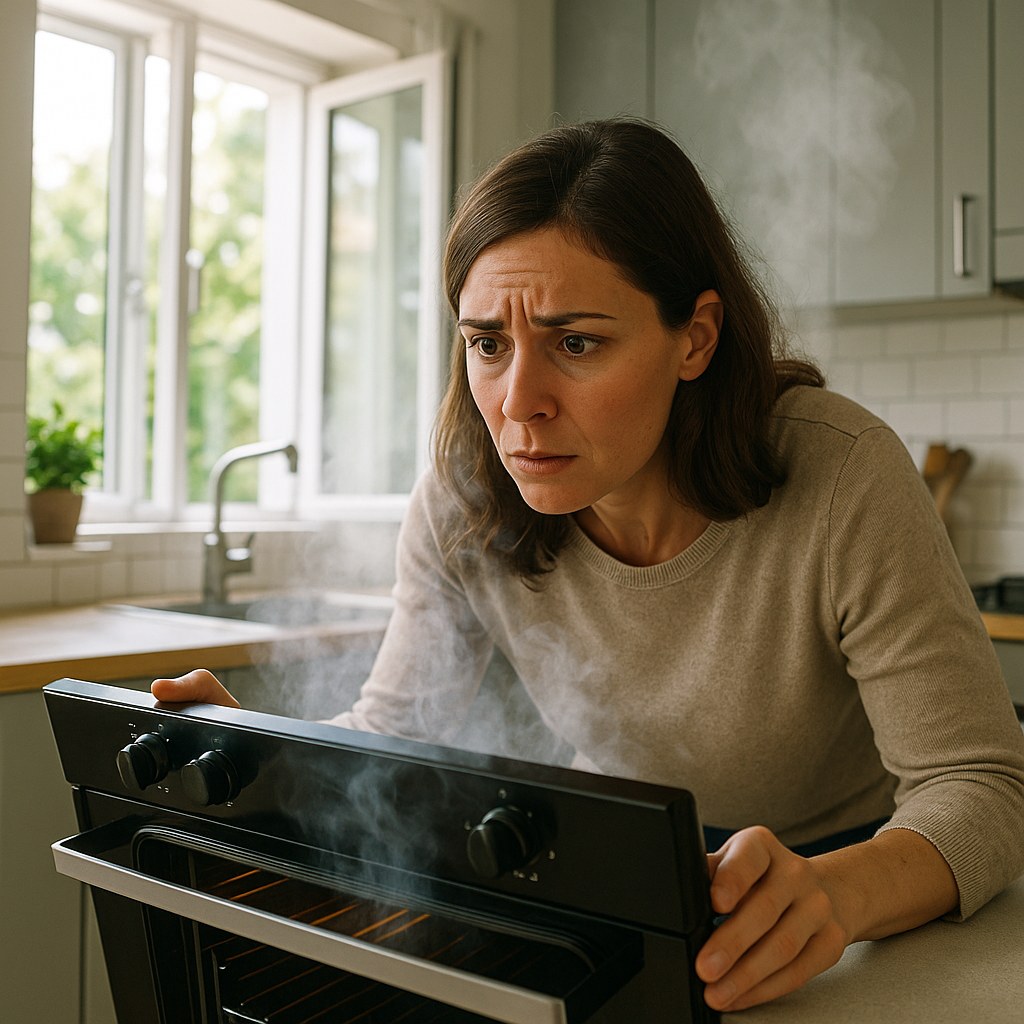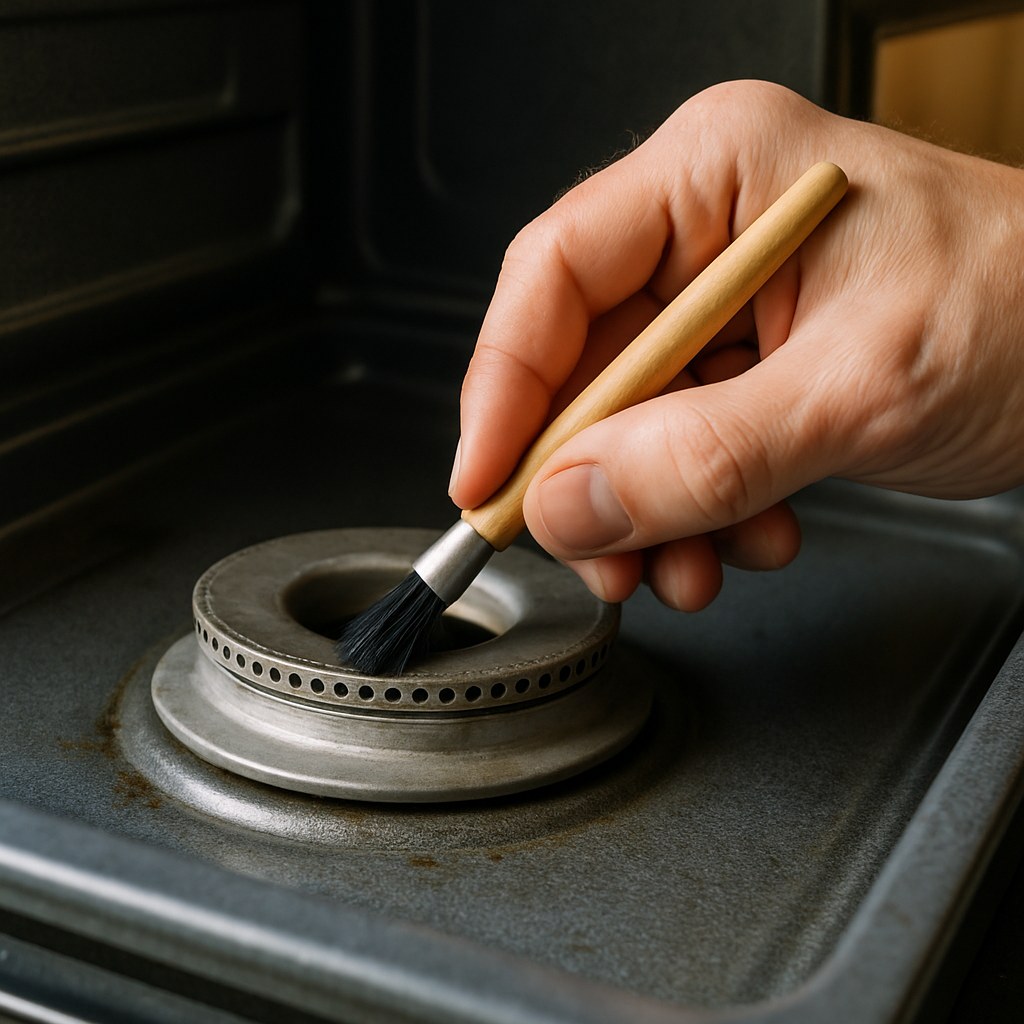You’re preheating the oven for dinner, and suddenly, a plume of smoke and a nasty burning smell fill your kitchen. It’s an alarming moment that can send anyone into a panic. Is the oven broken? Is there a fire?
Take a deep breath. While a smoking oven is definitely something you need to address immediately, the cause is often simple and something you can fix yourself. Most of the time, it’s just leftover food or grease from a previous meal making a dramatic exit. However, it can sometimes signal a more serious issue with a heating element or gas burner.
Cooking equipment is the leading cause of home cooking fires, so it's crucial to address this safely. In this guide, we'll walk you through everything you need to do, step-by-step. We'll start with immediate safety precautions and then help you diagnose and fix the root cause, whether you have a gas or electric model. Let’s get your kitchen back to smelling like delicious food instead of smoke.

Safety First: What to Do Immediately When Your Oven Smokes
Before you start troubleshooting, your number one priority is to make sure the situation is safe. A little smoke is one thing; a fire is another.
If you see heavy smoke or flames:
- Keep the oven door closed! This is the most important step. Opening the door introduces oxygen, which will fuel the fire and could cause it to flare up dangerously.
- Turn off the oven. Press the "Off" or "Cancel" button, or turn the temperature knob to the off position.
- Evacuate and call for help. If the flames are significant or don't go out after turning off the oven, get everyone out of the house and call 911 or your local fire department immediately. Do not try to be a hero.
- Do NOT use water. If it's a grease fire, water will only spread the flames. Only use a Class B/C fire extinguisher if you are trained and it is absolutely safe to do so.
If you only see light smoke and no flames:
- Turn off the oven.
- Turn off the gas supply (for gas ovens). If you can safely reach it, find the gas shutoff valve behind your oven and turn it clockwise until it stops.
- Ventilate the area. Open your kitchen windows and turn on the range hood fan to help clear the smoke.
- Wait for it to cool. Let the smoke subside for at least 5-10 minutes before carefully opening the oven door to investigate.
Once you’ve confirmed there’s no active fire and the immediate danger has passed, you can move on to figuring out what caused the smoke in the first place.
Diagnosing the Problem: Four Common Causes of a Smoking Oven
Now that the kitchen is aired out, let's play detective. The source of the smoke usually falls into one of four categories.
1. The Usual Suspect: Burnt Food and Grease Spills
This is, by far, the most common reason for a smoking oven. A bit of cheese that bubbled over from last night’s pizza or grease splatters from a roast can sit on the oven floor or heating elements. The next time you preheat, that residue burns off, creating smoke and a foul smell.
How to Fix It: A Good Cleaning
- Ensure the oven is off and cool. For extra safety, unplug the oven or flip the corresponding circuit breaker in your home's electrical panel.
- Protect your hands. Put on a pair of oven mitts or heat-resistant gloves.
- Remove the racks. Take out the oven racks and set them on a protected surface, like a towel on your countertop.
- Scrape away large debris. Use a metal spatula or a plastic scraper to gently lift any large, charred bits of food from the oven floor.
- Wipe down the interior. Use a damp microfiber cloth to wipe down the inside surfaces, removing any loose ash or residue.
- Steam clean (optional but effective). Pour a cup of water into an oven-safe bowl, place it on the center rack, and close the door. Restore power and heat the oven to 350°F (175°C) for 10-15 minutes. The steam will help loosen any stubborn, baked-on gunk.
- Final wipe-down. Turn the oven off, let it cool completely, and then wipe the interior one last time.
After cleaning, run the oven at 350°F for about 10 minutes. If there’s no new smoke, congratulations! You’ve solved the problem.
2. The Self-Clean Cycle Surprise
The self-clean feature is fantastic, but it works by heating the oven to extremely high temperatures (around 900°F or 482°C) to incinerate food residue into ash. This process can, and often does, produce smoke and strong odors, especially if there's a lot of grease or debris inside.
How to Handle It:
- A little smoke is normal. If you're running a self-clean cycle and see some light smoke, this is usually part of the process. Make sure to ventilate your kitchen well by opening windows and using your range hood.
- When to stop the cycle. If the smoke becomes excessively heavy and fills the kitchen or sets off your smoke alarms, it’s best to stop the cycle. Press the "Cancel" or "Off" button. The oven door will remain locked until it cools down to a safe temperature, which can take over an hour.
- Clean up the aftermath. Once the oven is cool and unlocked, use a damp cloth to wipe out the gray ash left behind.
If your oven continues to smoke during regular use after a self-clean cycle, it might indicate a problem with the feature or that some residue remains.
3. Gas Oven Specifics: Clogged Burners
If you have a gas oven, the issue could be related to the burner. Food or grease can drip down and clog the small ports where the flame comes out. This can lead to an uneven, inefficient flame that produces soot and smoke.

How to Troubleshoot It:
- Turn off the gas supply! This is non-negotiable for safety.
- Inspect the burner. Once the oven is cool, remove the racks and use a flashlight to examine the burner ports at the bottom of the oven. Look for any visible blockages.
- Clean the ports. Use a small, stiff brush (an old toothbrush works well) to gently brush away any debris from the burner ports.
- Test it out. Turn the gas supply back on, ventilate the room, and set the oven to 350°F. Watch the flame. A healthy gas flame should be steady and blue. If it's yellow or orange, flickering, or still causing smoke, turn the oven off immediately. This indicates a combustion problem that requires a professional.
4. Electric Oven Issues: A Damaged Heating Element
In an electric oven, the smoke might be coming from a faulty heating element. Over time, these elements can blister, crack, or short out. When this happens, they can produce a very acrid, electrical burning smell and visible smoke.
How to Troubleshoot It:
- Turn off the power at the circuit breaker. Before you do any inspection, make sure there is no electricity flowing to the oven.
- Visually inspect the elements. There's a heating element at the top (for broiling) and one at the bottom (for baking). With the oven cool, use a flashlight to look for any blisters, cracks, bright glowing spots, or visible breaks in either element.
- Check the vents. Dust can sometimes accumulate in the oven's vent slots. Use a vacuum cleaner with a hose attachment to clean these out.
- Test it. Restore power and preheat the oven. Watch the elements through the window. If you see one of them glowing bright red in just one spot, or if the smoke returns and has a distinct chemical or electrical smell, the element is damaged and needs to be replaced.
When to Call a Professional Appliance Technician
While many causes of a smoking oven are simple DIY fixes, some problems require an expert. It's time to call a professional if:
- You've thoroughly cleaned the oven, and it still smokes during regular use.
- In a gas oven, the flame is yellow or orange instead of blue.
- You see visible damage, like cracks or blisters, on an electric heating element.
- The smoke has a strong chemical or electrical odor.
- You smell gas after turning the oven off.
Hiring a professional is an investment in your safety. According to Forbes Home, the average cost for an oven repair ranges from $150 to $400, depending on the part and labor involved. It's a small price to pay for peace of mind.
Final Thoughts
A smoking oven can be stressful, but by staying calm and following these steps, you can safely identify and resolve the issue. Regular cleaning is the best prevention—wiping up spills as they happen can save you from a kitchen full of smoke later.
For more expert home maintenance guides, personalized reminders, and a direct line to trusted professionals for those bigger jobs, download the Casa app today! We're here to help you manage your home with confidence, from fixing a smoking oven to tackling your next big renovation project.

